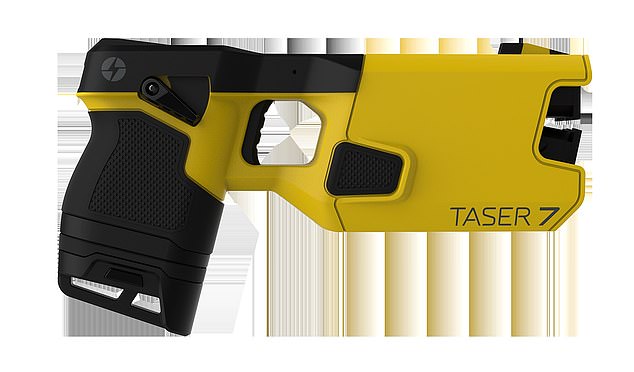Priti Patel’s Taser shocker: Home Secretary lets police use ‘more painful’ stun guns that experts warn can pose a risk to passers-by
- Scientists warned Taser 7 may lead to more internal injuries and broken bones
- It will be up to individual forces if they buy the Taser 7 and train officers to use it
- Miss Patel said the model is a ‘safe and effective tool for apprehending criminals’
Priti Patel yesterday authorised the police to use a ‘more painful’ Taser stun gun which could cause more serious injuries.
The Home Secretary has given formal approval for forces to use the new Taser 7 for the first time.
Her move came despite an analysis by Government scientists that the weapon could lead to more suspects suffering internal injuries and broken bones.
They also warned that passers-by now risk being hit by probes which inflict the electric shock as the Taser 7 allows them to detach from the gun after being fired.
The Taser, introduced in Britain in 2003, incapacitates a target with a high-voltage electric pulse which causes muscle spasms.
The Taser 7 also makes a louder ‘arc’ noise – a kind of electric crackling – before firing which aims to make violent suspects back down
The scientists said the Taser 7’s probes are more powerful than previous models and this implies it will be more effective but ‘may be more painful for the subject’.
They added that ‘free-flying probes… present a hazard to bystanders and officers located down-range of the subject in the event of a probe miss’.
Once detached from the muzzle of the weapon, probes can travel up to 80ft, said the experts.
Suspects shocked by the Taser 7 may have ‘an elevated risk of internal injury’ and such injuries ‘may become more prevalent’, the assessment went on.
The shock it generates ‘may elevate the risk of skull and other bony injuries associated with uncontrolled falls and may increase the risk of musculoskeletal injury due to a more forceful muscle contraction’.
The probes have more momentum so there is ‘an anticipated increase in the incidence of darts penetrating the body to their full depth’.
This means ‘injuries to deeper-lying organs and tissues may become more common’, added the Scientific Advisory Committee on the Medical Implications of Less-Lethal Weapons.

Miss Patel said: ‘It is sickening that our brave police officers face assaults and attacks as they work tirelessly to keep us all safe.’
Its analysis was published alongside Miss Patel’s announcement.
The Taser 7 also makes a louder ‘arc’ noise – a kind of electric crackling – before firing which aims to make violent suspects back down.
Miss Patel said: ‘It is sickening that our brave police officers face assaults and attacks as they work tirelessly to keep us all safe.
‘They are our protectors and I will do everything in my power to give them what they need to keep themselves and the public safe.
‘This new Taser model will provide a safe and effective tool for apprehending criminals.’
The stun guns were used in 23,000 incidents in the year to March 2019 but only fired in 2,700.
It will be up to individual forces if they buy the Taser 7 and train officers to use it.
Last September the Government announced a £10million fund to significantly raise the number of officers carrying a stun gun.

Standoff footage shows police officers carrying shields and armed with Tasers
The National Police Chiefs’ Council said the new model has ‘passed rigorous independent scientific and technical assessments’.
Spokesman Deputy Assistant Commissioner Lucy D’Orsi added that all officers on patrol with a Taser will have body-worn video.
Oliver Feeley-Sprague, of Amnesty International UK, called Miss Patel’s move ‘extremely worrying’.
He said: ‘The Taser 7 is set to be the most powerful electroshock device ever put in the hands of the British police. Its introduction comes at a time of mounting concern over Taser misuse, including against children and people from ethnic minorities.’
A thorough review into the use of Tasers is ‘more urgent than ever’, added Mr Feeley-Sprague.
